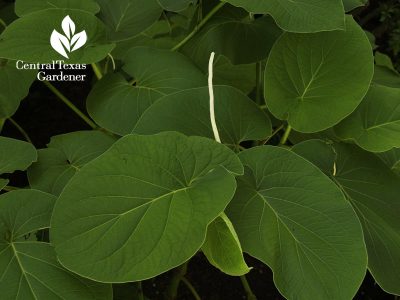Tropical Edibles

For most of these plants I fertilize regularly with an organic fertilizer, especially when the plant is containerized. Keep all of these (including the Dragonfruit) from going bone-dry to protect fruit production and essential oils in the leaves.
- Tea Hibiscus– variety shown is Hibiscus acetosella, aka False Roselle
While Roselle hibiscus is the primary “tea” hibiscus this species (acetosella) is also used for tea and the leaves are edible as well. Plant in afternoon shade and protect from frost. Can get leggy and rootbound in smaller container.
- Hoja Santa- Piper auritum, aka Root Beer Plant
Used in Mexican cooking where fish and chicken are wrapped in the leaves and baked or smoked. Can take full sun, but will wilt in the afternoon summer sun. Best grown with afternoon shade. Reliably winter hardy here. Grows to 8 plus feet and can be invasive.
- Avocado- Persea americana, variety shown is Lila
Other varieties for Central Texas include Joey, Pancho, Pryor, Opal, Wilma, and Fantastic. Hardy to 25 young, can take 15 when established. Will need two varieties for pollination. Protect from summer sun when young (can sunscald), but will need full sun afterwards. Growth to 50′ can be controlled by pruning out the top leader (branch). Leaves are used like bay to add flavor to soups and sauces.
- Cinnamon– Cinnamomun zeylancium
Protect from hard frost, may survive short periods of freezing temperatures. Grow in morning sun in a large pot. Prune back to the ground after 2-3 years which will cause the tree to sucker from the roots. These stems can then be harvested every other year and the inner bark removed. This is the cinnamon. The leaves can also be used as a cinnamon flavoring.
- Allspice– Pimenta dioica
Fresh leaves can be used in cooking and in teas. Grow a large pot and protect smaller plants from extreme afternoon sun. Greater cold tolerance as tree ages, but still must be protected from hard frosts. Plants are male or female, and it is impossible to tell until they fruit, which they do not do reliably here.
- Cardamom- Alpinia nutans
Evergreen if protected from frost. Turns brown in colder weather, can lose in a frost. Will become rootbound fairly quickly and will dry out faster, so repotting or dividing may be necessary every year. Can grow to 5′ plus in the ground, but tends to stay much shorter in a container. Keep in light shade for best results.
- Galangal– Alpinia galangal
Grows to 5′ in light shade. Most gingers do not like our full summer sun. Hardy most years if well mulched in the winter. Do not over water when dormant in winter or rhizomes may rot. Harvest by digging out around plant and remove small pieces of the rhizome as needed. The flavor is stronger than basic ginger.
- Aloe Vera– Aloe vera
Grows best in shade, either under a tree or on a porch in a large pot. Water when dry, but do not let go too dry or plant with lose vigor and may not recover completely. Divide as needed and share the offsets with friends. Juice can be made from the pulp and of course the inner pulp is also critical for treating sunburns.
- Lemon Grass– Cymbopogon flexuosus (East Indian) and citratus (West Indian)
We grow both species here in central Texas. East Indian is grown for its lemon flavored leaves. It grows to 2.5′ and is marginally winter hardy. West Indian is the lemon grass stalks used in Thai cooking and it taller and more winter hardy here. Both can take full sun to high shade and are drought tolerant.
- Kaffir Lime- Citrus hystrix
Will probably survive to 25 when established, but protect for insurance. Full sun light shade. Can get very large in a container (10′ plus) and has large thorns. Freshleaves are used in cooking. Fruit is very tart and used mainly for zest for most cooks. Care is same for most containerized citrus. Use an organic citrus fertilizer like Citrus-Tone several times per year for strongest growth.
- Curry Tree- Murraya koenigii
This is the true source of curry in Indian cooking. It will survive most years grown outside here in central Texas in a protected location, although it is probably more reliable in San Antonio. Can sucker and spread by seed, so be diligent about removing new plantlets that crop up underneath the mother plant. Can grow to 10′, but can be pruned severely every year to control height. Leaves are best used fresh.
- Dragonfruit- Hylocereus sp., variety shown in VooDoo Child
Very heat tolerant, but like many cacti and succulents a little afternoon shade in the summer will keep them nice and green (they tend to get red in the hot sun).
Protect from hard frosts. Native to the Americas. Fruit is produced one to two months after flowering (night blooming, fragrant flowers). The variety shown is self-pollinating, but many varieties need a pollinator. Very vigorous cactus vine. Will need a large container eventually and lots of sturdy support to grow on.
Tends to begin fruit production when plant weight reaches 10 pounds.
categories:
tags:
related:
appeared on episodes:

 Amanda Moon
Amanda Moon